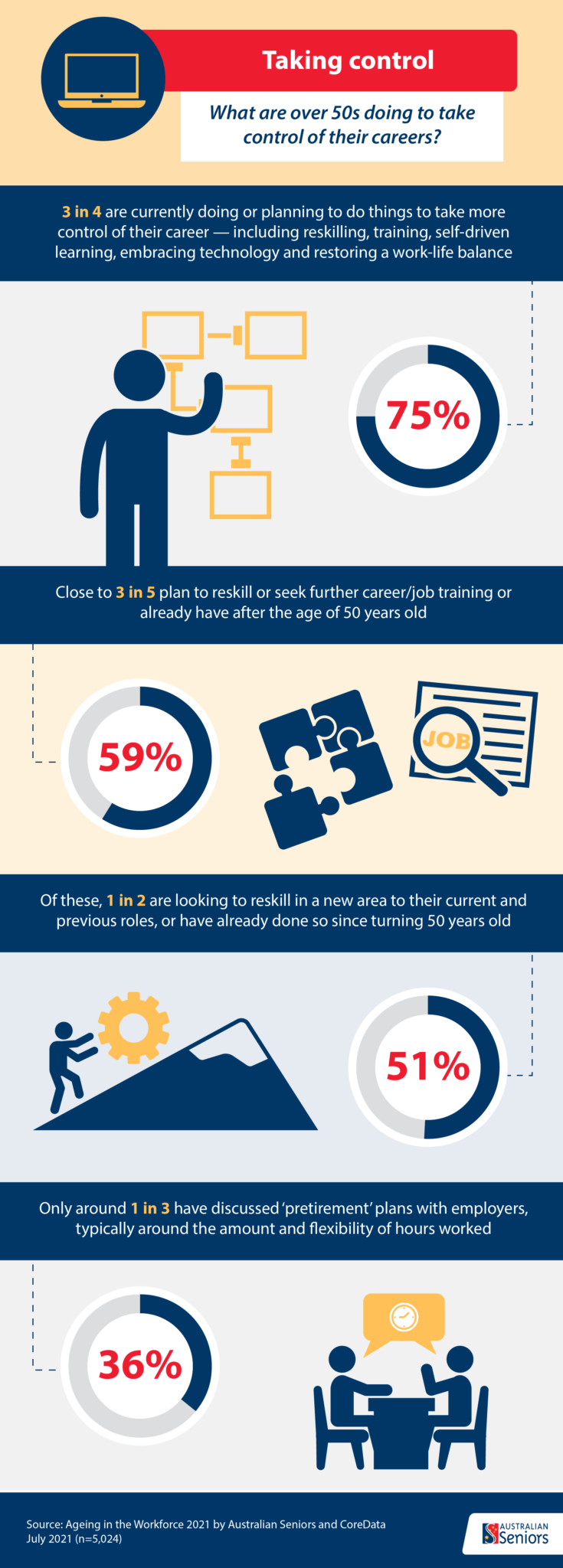
Not only does ageism in the workforce continue to dog the lives of older Australians, but it is getting worse.
This is despite older Australians wanting to stay active in the workforce in some capacity.
Findings from The Australian Seniors Series: Ageing in the Workforce 2021, reveal one in five (20.7%) older Australians experienced age discrimination at work, twice as high as reported in 2016 (9.6%).
Most of the 5,000 Australians over the age of 50 (93.2%) surveyed in the in depth study feel older employees are undervalued and almost all (97.7%) think it is harder to find a job the older they get.
Almost three-quarters (74.9%) are currently undertaking or planning efforts to take more control of their careers now and into the future (i.e. reskilling or training, driving work-life balance, embracing technology, self-driven learning, and/or adapt/change working role or career).
Almost three-fifths (58.7%) have plans to reskill or seek further career and job training and over one in two (51.2%) of this subset are doing so in a new area or field to current or previous roles.
According to the research, there is a growing need for the Australian Government to get more involved in assisting the ageing workforce, especially with the Baby Boomer generation making up more than 20 per cent of the country’s population.
The majority (94.0%) of those surveyed acknowledge the government’s need to provide more tangible support for seniors working later in life such as, training/reskilling programs, supportive working conditions and policies. Furthermore, most (95.7%) seniors note equality for over 50s should be mandatory in Human Resources and Diversity & Inclusion strategies too.
The study explored the current experiences in the workforce and retirement of those surveyed, as well as the impacts of COVID-19, whilst shedding light on the ongoing barriers of ageism faced by Australia’s ageing workforce.
Over two-thirds (69.2%) of respondents know or believe they were turned down for a job based solely on their age, which is a 20 per cent increase over the last five years (47.1%).
For those planning to re-enter the workforce, almost four-fifths (78.2%) lack confidence with their prospects and even more (84.5%) see barriers to achieve their goals.
Additionally, over half (52.6%) argue the pandemic has made the task of finding a job much harder, with close to one in 10 (9.3%) ending their job search and more than a quarter (26.2%) attempting to give the impression they are younger either at work or during the job application process.
However, there is a strong opportunity for employers to hire over 50s due to the implications of COVID-19.
The survey revealed more than three-quarters (75.7%) of Australians over 50 would work indefinitely if they were well supported and had flexible working conditions.
Although financial requirements do prevail as the main reason to stay in the workforce after 67 (64.9%), over half (52.1%) experience enjoyment from working and (46.2%) want to maintain a sense of purpose.
Sydney-based organisational psychologist, Humphrey Armstrong whose work at Lifelong Learning Systems focuses on helping people make the most out of their later-life career and retirement transitions, said the increasing need to find talented, experienced staff presented a great opportunity for organisations to consider retaining and hiring older people.
“As the survey results indicate, many seniors are wishing to work longer and the statistic of 89 per cent of current retirees considering re-entering the workforce suggests older Australians are an important, relatively untapped talent pool,” said Mr Armstrong.
“The shift to flexible and remote working arrangements, which are especially attractive for many older women who are keen to secure flexible part-time jobs, means new employment opportunities are now emerging, due in part to the on-going COVID-19 pandemic,” he added.
Amanda Mackean, Founder and Director of Seeking Seniors, a job and recruitment agency for Australia’s over 45s agreed saying: “Our economy is not going to get out of this ravaged state unless we alter our standards and employ Australia’s over 50s.
“A misconception is that older Australians are looking for those senior and “career-defining” roles, but the truth is they want a different pace. Thus, companies have an opportunity to bring in their expertise in a variety of mid-level vacancies.
“Having come up against age discrimination first-hand during my career, I’m hopeful that a wider understanding of the positive contributions over 50s bring to the workforce, will help thousands of seniors facing ageism.”
Other findings from the research
Age discrimination and taking control
- Over one-quarter (25.1%) of seniors felt that employers start to look at employees differently between the ages of 40-49, almost half (47.3%) say that this occurs between the ages of 50-59
- More than half (54.6%) of females are more impacted by ageism in the workplace than men (10.2%)
- Females were more likely to think this than their male counterparts (70.5% vs. 37.2%),
- Males twice as likely to think that females were more impacted than them (37.2% vs. 18.5%)
- Half (50.2%) have had offensive, annoying assumptions made about them (close to a 30% increase in 2016 – 21.0%)
- Over 2 in 5 (42.7%) felt patronised due to their age, which has tripled since 2016 (13.6%)
- Over 1 in 4 seniors (26.2%) admitted that they have tried to give the impression they are younger at their workplace or when applying for jobs past the age of 50 years old
Including: wearing or considering the latest fashion looks (42.0%), getting a modern haircut (45.6%), wearing the latest makeup (26.1%) and more drastically, cosmetic surgery to look younger (13.6%)
Retirement and ‘Preretirement’
- Majority (90.4%) identify wage levels and superannuation savings do not typically meet actual retirement needs
- Over 4 in 5 (83.4%) feel to some or a great extent, there is a gender gap in superannuation balances. These are due to career punctuation (64.7%), the wage gap (58.4%) and view females have less financial confidence (23.9%)
- Over 1 in 10 (15.8%) of those retired or semi-retired planned and achieved the exact age they would retire
- Over 7 in 10 (72.8%) of those retired or semi-retired did not actually have plans in place for retirement, which suggests many slip into retirement
- Over 4 in 5 (82.1%) struggle with the concept of fully retiring
- Only 1 in 5 (18.8%) have planned what age they would like to retire, but over 1 in 3 (34.8%) are not confident they will be able to pull this off. Over 1 in 3 (35.9%) have vague plans of retiring, while over 2 in 5 (45.3%) have no plans at all when they will retire
- Just over 1 in 3 (36.0%) have discussed ‘pretirement’ plans with their employer
- Over 2 in 3 (67.1%) feel it is important to have ‘pretirement’ discussions with their employer. These discussions typically include: working fewer days (16.9%), flexible hours (14.3%), reducing hours (11.6%)
SheSociety is a site for the women of Australia to share our stories, our experiences, shared learnings and opportunities to connect.




Leave a Reply